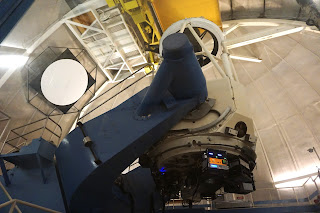March 3, 2017
March 3, 2017
Southern Arizona, with its dry weather, clear skies, and
scattered mountains, is a mecca for astronomers. This morning we left early with our neighbors to drive sixty
miles southwest to Kitt Peak. It is another twelve miles of windy road to reach the
7000-foot summit. This mountaintop is
the home of the National Optical Astronomical Observatory. The Soviet launch of
Sputnik in 1957 spurred the USA to setup this government agency to fund and expand
astronomical science. One of the first
projects was the development of Kitt Peak.
Kitt Peak today is crowded with more than two-dozen
telescopes. Three are open to the
public. We sign up for a guided tour of
each. The first up is the
McMath-Pierce Solar Telescope. It is
not only massive, but unlike any others. It is 500-foot long and angled at our latitude of 32°. More than half of the length is buried in
the mountain. On sunny days (not today)
a large mirror is pulleyed up to the top.
Sunlight is bounced down the length and then back up to the
surface. There, a detailed yard-wide
solar image can be studied. Despite its
size, this 55-year old instrument is now rarely used and is ready for the trash
heap.
Our second tour is to one of the oldest telescopes, the
84-inch. Finished in 1964, it originally
was fitted with a camera. Now telescopes
uses digital sensors or more likely spectroscopes for analyzing the different
colors of the light.
After eating our picnic lunch in the car, our third tour is
a half mile hike to the largest telescope, the Mayall 4-meter (158 inch). We can easily see this 19-story behemoth
from Tucson. Data from this instrument led to the new but controversial theory
of dark matter. As a bonus, from the outside observation deck we get a great view of the mountain and the surrounding valley.
Despite the size of the telescopes on Kitt Peak, none of
them break into the top 25 largest anymore. Money is now pouring into mega
telescopes that use multiple mirror arrays. Kitt Peak is becoming a dinosaur
and is in danger of losing its funding.
The new telescopes are moving to Chile and Hawaii; both are much higher
and less tainted with urban light.




0 Comments:
Post a Comment
<< Home